No-Gi Submission Spree With Garry Tonon

In the promotion of his match against Kit Dale leading up to Metamoris 4, we got a glimpse of Garry Tonon and his work ethic. The term “the hardest working man in…” is very cliché, but in the case of Garry Tonon, it might just apply. Garry (with two R’s) hails out of Brunswick, New Jersey and is a black belt under Tom DeBlass. Garry starts every morning with his own training, usually a morning or an afternoon session at one of three academies, Tom’s school, Ocean County BJJ, Ricardo Almeida Jiu-Jitsu or Renzo Gracie Academy (That also happens to be Garry’s belt lineage; (Renzo Gracie – Ricardo Almeida, Tom DeBlass). After his own training and sharpening of his skills Garry teaches evening classes at Brunswick BJJ from 5 until 10 daily. Being just 22 helps with Garry’s hectic schedule and if there was ever a case for “eat, breath, sleep” jiu-jitsu Garry just might be able to make it.
Garry’s made a name for himself in the No Gi circuit and saw a nice rise in his stock after his epic match against Kron Gracie at the 2013 ADCC in China. In that match he somehow avoided a deep armbar and took Kron’s back until ultimately being submitted via Garry’s favorite finish, the rear naked choke. That loss turned into a win thanks to the respect he earned from much of the jiu-jitsu community, along with the organizers at Metamoris who put Garry on the card against Kit Dale at the fourth installment of the event. It was a quick finish for Garry who submitted Kit via guillotine at the 3:40 mark of the match. In this article Garry’s going to show us some of his favorite techniques, including the guillotine he used against Kit at M4.

5 Questions With Garry
Do you prefer points or sub-only tournaments?
Sub-only has really opened up my success in competition. I think sub-only tournaments have shaped my style. In training I find myself not as worried about getting my guard passed or passing the guard. I work more with what the person is giving me. Before, I would focus on my passes, sweeps and getting to the back. I’m definitely not afraid to concede position. If I’m on top and I feel like rolling to the bottom so I’ll get closer to getting someone’s back or leg, I’ll go for it. I feel more confident falling back for a guillotine. I never used to get guillotines; that only happened in the past six months. Sub-only has really opened up my game to so many more submissions; I used to only rear naked choke people.
Is that your favorite finish?
Yeah, still to this day taking someone’s back is still where I want to be. I hear people stressing that it takes a lot of energy to finish, but for me I feel secure there. Occasionally I don’t finish, like the match with Kron, but that’s where I feel most confident. I’m really trying to expand my submission base, but that’s still my favorite.
What are your goals for this year?
I’d like to win the No-Gi Pan and the Worlds (Editorial Note: Garry is a 2x winner of both the IBJJF No-Gi Pan and Worlds at brown belt); Grappler’s Quest Olympics is coming up and has a cash prize that I’d like to win and FIVE’s North American Championship is coming up in Florida.
How was your Metamoris experience?
It was great! I’ve been looking up to guys like Andre Galvao since I was a white belt and to share the stage with him was pretty awesome. Dean Lister is another guy that I really admire, his leg locks are amazing and inspiring. All of those guys…it was pretty cool to share the stage with them.
How about a rematch with Kit in the Gi?
I really respect Dale for fighting me in my style, with all the heel hooks, leg locks included. If I’m going to consider myself a true martial artist I should be willing to accept his challenge in his style. I know that Kit’s had more success in the gi, so I’d do it. I’d train for it in the gi and I still think I’d be successful.
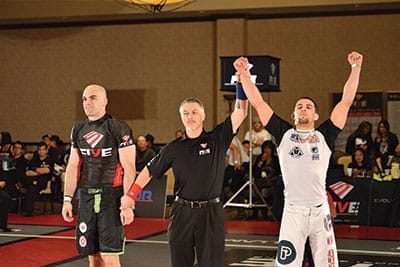

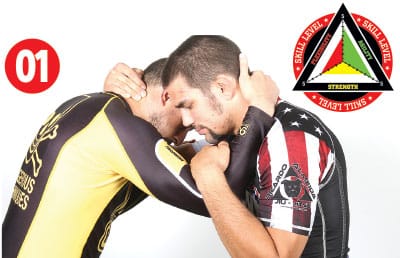
High Elbow Guillotine
If you watched Metamoris 4 you’ll recognize this choke – it’s the high-elbow guillotine that Garry submitted Kit Dale with. Garry starts the move with a wrestler’s tie up. The technique would be very similar in a gi as well.
Starting with collar ties, whenever Garry is looking for an underhook, he’ll drop that side, in this case the left, and then cut in for a short underhook with his hand to his opponent’s neck.
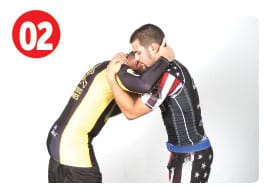
Now Garry has a short underhook on the left side and the other hand on the back of the head. This gives him good control of his opponent’s upper body.Garry prefers to have control of the crown of the head versus the neck, this makes it more difficult for his opponent to posture up.
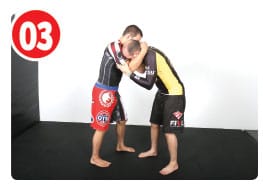
At this point, many people will go for the guillotine, but this would be a mistake. If the opponent postures up too soon he might end up taking Garry’s back.
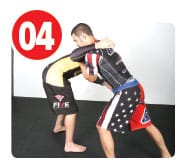
Garry steps back and pulls his opponent down until his head is at or below Garry’s right shoulder.
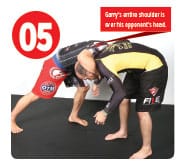
Once his head is down, Garry brings his arm up and over his opponent’s neck.
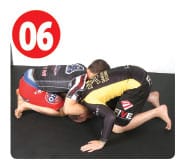
Next, Garry snaps his opponent down to the mat. He doesn’t go straight back, instead he snaps him down to his left, the side opposite his opponent’s head. This puts the most amount of pressure on his opponent.
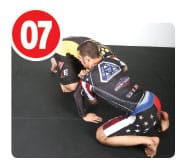
When his opponent hits the mat he’s forced to at least post with one hand to the mat or else he’s going to smash his head. When he does this it opens up the opportunity for the guillotine.
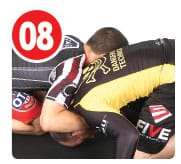
Garry then cups his hands together as shown underneath his opponent’s chin.Putting his hands together at the chin allows Garry to continue the choke if his opponent defends to one side, the other side opens up as an option to finish.
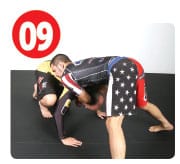
With arms in place, Garry jumps to his toes so his knees aren’t exposed for his opponent to defend with some sort of takedown. This also puts more pressure on the opponent.

Now Garry picks a side and slides his right arm deeper under his opponent’s neck while bringing his right thigh up along the head. While doing this movement, Garry’s also dropping his head to his opponent’s left shoulder and his left elbow is up high with his hands clasped.The trick here is not the arm position, but the rotation of Garry’s body. The placement of the knee prevents the other guy’s head from popping out when Garry rotates for the finish.

A common way to defend this choke is for the opponent to fall to the side with Garry when he goes for the finish, this is what Kit Dale did at M4. To prevent that, Garry keeps his left leg posted out until just before he goes for the rotation. As he begins to rotate, he quickly brings his left heel up and over to his opponent’s back.Bringing the leg over helps Garry to go with his opponent and keep the choke, even if he falls all the way to his back.

At this point the finish for Garry is to drive his hips down and pull his wrists up.

Back Take with Shoulder Roll from Mount
So, let’s say you’ve mounted your opponent. This is one he definitely won’t see coming. The first technique Garry shows us is if your opponent feeds into it by attempting to recover guard and then when he’s not very active. Either way, it’s a slick move that will definitely catch him off guard.
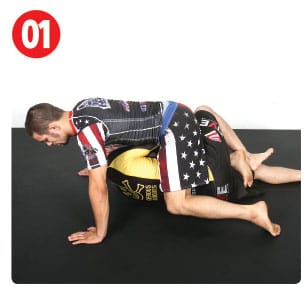
Garry starts mounted on his opponent. This first action is reactive to what his opponent gives him. A typical escape from the mount would have the guy on the bottom bending one knee, and one straight looking to recover to at least half-guard.
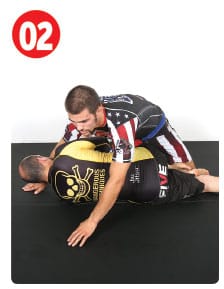
Once he’s in half-guard Garry puts weight on his opponent’s leg by sitting back. If he allows his opponent to get flat on his back it makes things much more difficult.
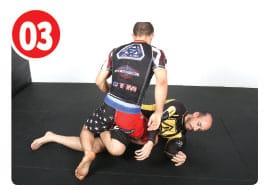
At this point Garry can lock up a figure four with his own legs, this is great if he can get it, but what’s more important is keeping weight on his opponent and starting the roll as quickly as he can.
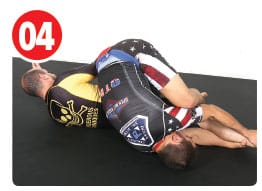
Garry begins his roll by tucking his head and rolling his right shoulder to the mat.
Little tip here, Garry always reaches for the feet so he knows which way to roll.
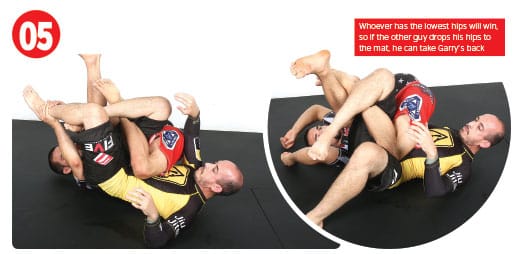
Garry continues the roll to his back, at this point it’s an even situation. Quickly, he drops his hips down and uses his arms to keep his opponent’s hips from dropping.

Garry extends his legs out like a lock down on his opponent’s leg to help bring his back to Garry.
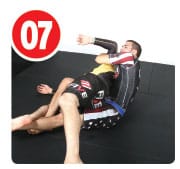
Right away Garry grabs his opponent’s upper body, his arms, his neck, anything to keep him from turning into him.
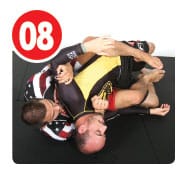
Finally, Garry adjusts his hips, and gets his other hook in so he can go for his favorite finish from the back.
Alternate
If Garry’s opponent isn’t trying to recover and really isn’t giving him anything, all Garry needs is one knee bent. In that case, he’ll bring one leg through the bent knee and force his opponent onto his side with his weight. From there, he would go straight to Step 2 and then finish the rest of the technique.

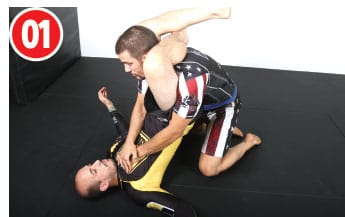
Garry starts in a bad spot, his opponent has a triangle locked up, so the first thing Garry does is posture up, but that’s not enough. As he postures up Garry drops his knees beneath his opponent so he can’t crunch him back down.
Triangle Escape With Leg Lock Finish
Nobody likes being in a triangle, but you can definitely make some sweet tasting lemonade from lemons with two options for a leg lock finish from being stuck in the triangle. The first is a heel hook that’s not legal in many tournaments, so check the rules. The other is more compliant for the rest of us.
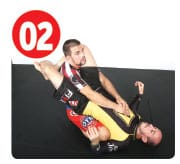
From here Garry might be able to get out of it, but if it’s really tight he needs more posture. He places both hands on his opponent’s chest to help bring himself to his feet.
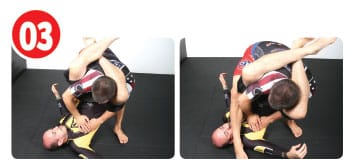
Once on his feet, he chooses a side. Garry likes his right side so he steps his right foot over his opponent’s body then drops his butt down to the mat.
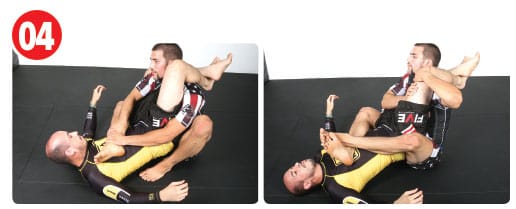
Quickly, he fights to also bring his left leg over, which he then crosses over his opponent’s torso. As soon as he has both legs crossed, he postures back using his entire body to break the triangle using his hands as well.
From here there are a ton of leg locks that present themselves. When legal (check tournament rules), Garry likes the heel hook.
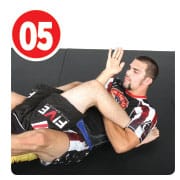
A. He overhooks the target leg while pushing the other one away.

B. Garry pivots to the side of the target leg, while threading his left leg through his opponent’s legs creating a figure 4.
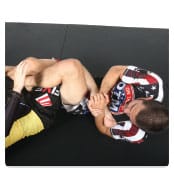
C. He turns his body to the heel, bending his left arm to hook the heel. Then he finishes twisting his body away to bring his opponent’s heel upward and to the right.

For a more legal finish, Garry’s chosen a straight ankle lock that can be done at most competitions, all the way down to white belts and beginners.

A. Garry picks the right ankle to attack and gets an overhook with his left arm holding it tight between his arm and body up near the armpit.

B. He then pushes the left leg away and brings his right knee up between his opponent’s legs to isolate the target leg.
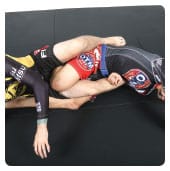
C. Next, he rolls to his left to get to a belly-down position with the leg and ankle in tow.
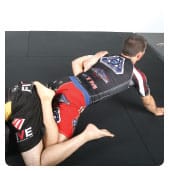
D. Garry adjusts the hold so that the top of his opponent’s right foot is up against Garry’s left triceps and he bridges into the target leg with his right hand on the mat.
Head and Arm Guillotine From Back Escape
Who gives up the back to get a dramatic finish from the guard? This guy! Maybe it’s not the first option, but let’s say your opponent manages to break free of your seatbelt when you have his back, no worries. This is another one of those techniques that Garry does that makes due with what you have.
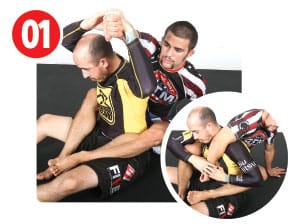
Garry has the back, hooks in with a seat belt. A common defense for his opponent is to lift the arm that’s over the shoulder and sneak the head out to escape a choke. When his opponent does this, Garry goes with it.
[/double_paragraph][double_paragraph]
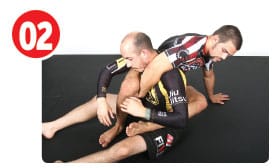
Garry wants to grab his own right knee with his right hand after the neck escape. To do this, Gary posts his left hand to the mat twisting a bit so he can feed his right knee to his right hand.
[/double_paragraph] [/row]
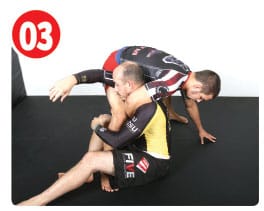
He makes a connection by grabbing the underside of his own right knee. Once this connection is made, Garry technically stands out to his left side.

With nowhere else to go, Garry’s opponent turns toward him. As he does this, Garry brings his hands together to secure the guillotine and falls back into guard.

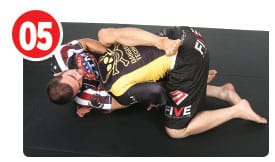
Garry brings his left leg over to hug the back and finishes with a normal head and arm guillotine.

Technical standup: a move to transition from a seated position to your feet while being able to protect yourself from attack.
